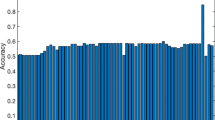Abstract
The existence of nosocomial infection prevision systems in healthcare environments can contribute to improve the quality of the healthcare institution and also to reduce the costs with the treatment of the patients that acquire these infections. The analysis of the information available allows to efficiently prevent these infections and to build knowledge that can help to identify their eventual occurrence. This paper presents the results of the application of predictive models to real clinical data. Good models, induced by the Data Mining (DM) classification techniques Support Vector Machines and Naïve Bayes, were achieved (sensitivities higher than 91.90%). Therefore, with these models that be able to predict these infections may allow the prevention and, consequently, the reduction of nosocomial infection incidence. They should act as a Clinical Decision Support System (CDSS) capable of reducing nosocomial infections and the associated costs, improving the healthcare and, increasing patients’ safety and well-being.
Access this chapter
Tax calculation will be finalised at checkout
Purchases are for personal use only
Preview
Unable to display preview. Download preview PDF.
Similar content being viewed by others
References
Clean Care is Safer Care Team: Report on the burden of endemic health care-associated infection worldwide: Clean care is safer care. Technical report, World Health Organization (2011)
Inweregbu, K., Dave, J., Pittard, A.: Nosocomial infections. Continuing Education in Anaesthesia. Critical Care & Pain 5(1), 14–17 (2005)
Rigor, H., Machado, J., Abelha, A., Neves, J., Alberto, C.: A web-based system to reduce the nosocomial infection impact in healthcare units. In: Proceedings of the WEBIST 2008 - International Conference on Web Information Systems, Portugal (2008)
Koh, H.C., Tan, G.: Data mining applications in healthcare. Journal of Healthcare Information Management 19(2), 64–72 (2005)
Fayyad, U., Piatetsky-Shapiro, G., Smyth, P.: From data mining to knowledge discovery in databases. AI Magazine 17(3), 37–54 (1996)
Azevedo, A., Santos, M.F.: KDD, SEMMA and CRISP-DM: A parallel overview. In: Proceedings of the IADIS European Conference on Data Mining, Netherlands, pp. 182–185 (2008)
Paramasivam, V., Yee, T.S., Dhillon, S.K., Sidhu, A.S.: A methodological review of data mining techniques in predictive medicine: An application in hemodynamic prediction for abdominal aortic aneurysm disease. Biocybernetics and Biomedical Engineering 34(3), 139–145 (2014)
Hardin, J.M., Chhieng, D.C.: Data mining and clinical decision support systems. In: Berner, E.S. (ed.) Clinical Decision Support Systems, pp. 44–63. Springer, USA (2007)
Chapman, P., Clinton, J., Kerber, R., Khabaza, T., Reinartz, T., Shearer, C., Wirth, R.: CRISP-DM 1.0 Step-by-step data mining guide. Technical report, SPSS (2000)
Barua, S., Islam, M. M., Murase, K.: ProWSyn: Proximity weighted synthetic oversampling technique for imbalanced data set learning. In: Pei, J., Tseng, V.S., Cao, L., Motoda, H., Xu, G. (eds.) PAKDD 2013, Part II. LNCS, vol. 7819, pp. 317–328. Springer, Heidelberg (2013)
Oracle. Oracle data mining concepts, http://docs.oracle.com/cd/B28359_01/datamine.111/b28129/toc.htm
Kohavi, R., Provost, F.: Glossary of terms. Machine Learning - Special Issue on Applications of Machine Learning and the Knowledge Discovery Process 30(2-3), 27–274 (1998)
Author information
Authors and Affiliations
Corresponding author
Editor information
Editors and Affiliations
Rights and permissions
Copyright information
© 2015 Springer International Publishing Switzerland
About this paper
Cite this paper
Silva, E., Cardoso, L., Portela, F., Abelha, A., Santos, M.F., Machado, J. (2015). Predicting Nosocomial Infection by Using Data Mining Technologies. In: Rocha, A., Correia, A., Costanzo, S., Reis, L. (eds) New Contributions in Information Systems and Technologies. Advances in Intelligent Systems and Computing, vol 354. Springer, Cham. https://doi.org/10.1007/978-3-319-16528-8_18
Download citation
DOI: https://doi.org/10.1007/978-3-319-16528-8_18
Publisher Name: Springer, Cham
Print ISBN: 978-3-319-16527-1
Online ISBN: 978-3-319-16528-8
eBook Packages: EngineeringEngineering (R0)




